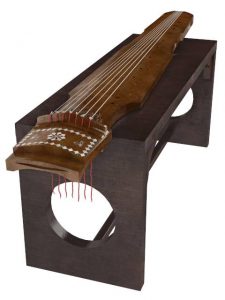

The first Chinese character of the name of the instrument ( 二, èr, two) is believed to come from the fact that it has two strings. The xiqin is believed to have originated from the Xi people located in current northeast China. It is believed to have evolved from the Xiqin ( 奚 琴). The erhu can be traced back to proto-Mongolic instruments which first appeared in China during the Tang dynasty. History Performer with erhu, photographed Singapore February 1969 × July 1971 As a very versatile instrument, the erhu is used in both traditional and contemporary music arrangements, such as pop, rock and jazz.

It is the most popular of the huqin family of traditional bowed string instruments used by various ethnic groups of China. It is used as a solo instrument as well as in small ensembles and large orchestras. This video of Fighting Against Typhoon played on the guzheng shows many of them.The erhu ( Chinese: 二胡 pinyin: èrhú ) is a Chinese two-stringed bowed musical instrument, more specifically a spike fiddle, which may also be called a Southern Fiddle, and is sometimes known in the Western world as the Chinese violin or a Chinese two-stringed fiddle. There are so many other techniques that are not just plucking the string. Guzheng players usually store their tuners, fingerpicks, extra strings, extra bridges, extra fingerpick tape, and basically anything that we would need in that compartment.ĩ. The wood piece to the right of the strings can open! It looks long and chunky, but many people are often surprised at how easily they can pick up the instrument and carry it for some distance.Ĩ. When plucking the left side strings, it can evoke the sense of thunder or horses’ hooves or terrible storms.Īn average guzheng is around 20 to 30 pounds. It doesn’t sound pretty, but it’s mostly for dramatic effect. Not only do we hold down on the left side, but we can also pluck the strings.

It takes a little practice to always reach the right pitch, but it will become muscle memory.Ħ. For “7,” they would bend down the “6” string So how would they play those notes if there’s no string for it? For “4,” they would bend down the “3” string until they hear the F note. This is because the guzheng is tuned in a major pentatonic scale. (Learning tip: Reading the numbers with solfège helps with memorizing music a lot faster.)Īlso known as the F and B note. Instead of reading the music as 1 2 3 or C D E, they would refer to their music as do re mi. Guzheng players refer to their notes in sol fège.

Even though they’re numbers, don’t refer to them as 1 2 3’s. (If there are two lines, the bottom line is for the left hand and the top line is for the right hand.)Ĥ. This is how numbered notation would be compared to notes. For example, two dots on top would mean to play the note two octaves higher. Each dot on top or bottom represents the octave that should be played. To represent a higher note there will be dots on the top and for a lower note there will be dots on the bottom. Placing the bridge to the right will make the pitch higher and placing it to the left will make the pitch lower.īasically, the sheet music still has bars and rests, but it replaces the notes with numbers. This is how the instrument stays in tune. The bridges that hold up the strings are moveable. These not only protect your fingers from blistering, but also make sure that the sound comes out bright and not muffled when the string is plucked.Ģ. As one increases in level, they would also wear the finger picks on their left hand too. Guzheng players use a cloth tape that was made to tape the picks on the top of their right hand fingers. These fake nails are actually called finger picks and they’re usually made out of turtle shell. No, not the ones you can get from the nail salon. The Guzheng, also known as the Chinese zither, is a wood plucking instrument that can have 21 or more strings. If you’re wondering what this harp-table looking instrument is, you’re in the right place.


 0 kommentar(er)
0 kommentar(er)
